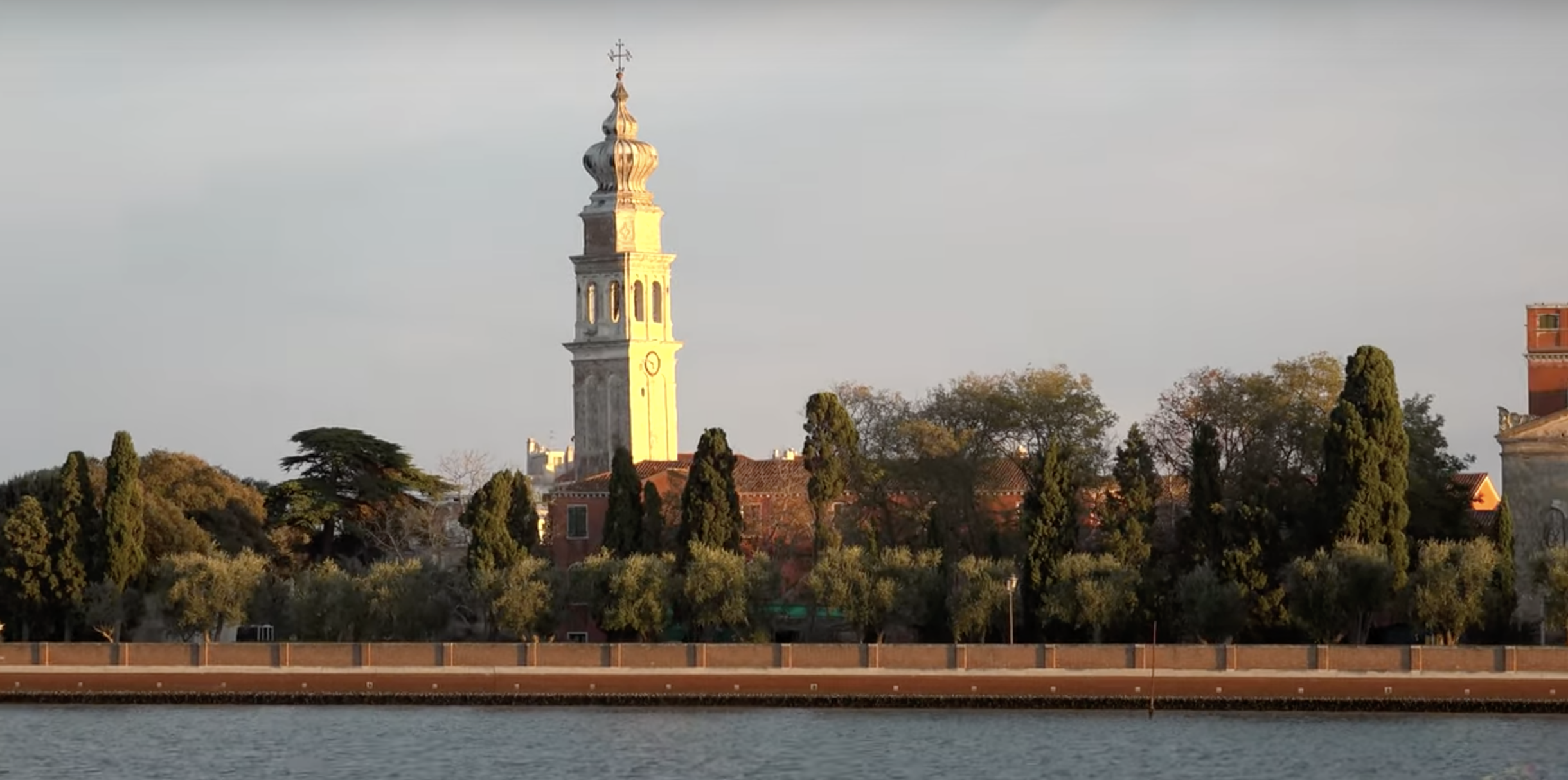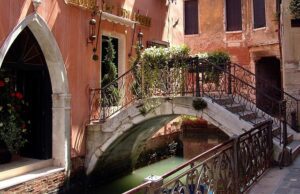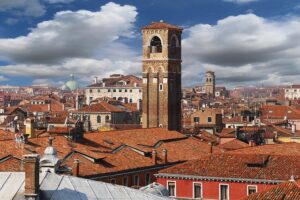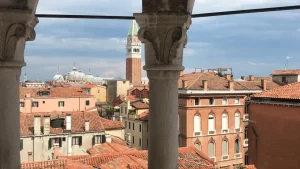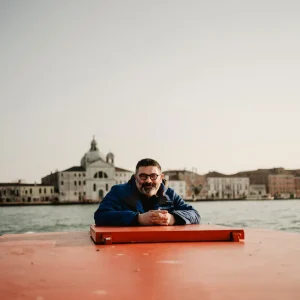San Lazzaro degli Armeni — Venice’s Island of Knowledge and Light
When you glide across the Venetian Lagoon, your eyes usually follow the familiar icons — the domes of San Marco, the curve of the Giudecca, the green shimmer of the Lido. Yet, between them lies a world few travelers ever see: San Lazzaro degli Armeni, one of the smallest and most extraordinary islands on Earth.
Just a few hundred meters wide, this island has guarded a priceless treasury of Armenian art, manuscripts, and learning since the early 18th century. Within its walls, monks still speak an ancient tongue, copy sacred texts, and welcome visitors into a sanctuary of silence, books, and light. For many, it becomes the most unforgettable stop of their Venetian journey — an encounter not with tourism, but with timelessness.
📍 1. Where Is San Lazzaro degli Armeni?
The island rests quietly in the lagoon between San Marco and the Lido, a short ride from the city’s heart. From the Riva degli Schiavoni, board the vaporetto Line 20 from San Zaccaria; in about 10–15 minutes, you’ll glimpse a cluster of red-brick walls, a slender bell tower, and cypress trees rising from the water. Unlike Murano or Burano, San Lazzaro is not a neighborhood — it’s a world apart, a self-contained island where the rhythm of prayer replaces the bustle of crowds.
🏥 2. Before the Monks — A Leper Colony of the Middle Ages
Centuries before it became a monastery, San Lazzaro was a place of exile. Named after Saint Lazarus, the patron saint of lepers, it served as one of Venice’s lazaretti — isolated hospitals where victims of leprosy and plague were sent for care and quarantine. The Republic, ever pragmatic, used the lagoon’s islands to protect the city from disease, surrounding the sick with water and prayer.
For hundreds of years, the island echoed with suffering and silence. Yet, in a pattern that defines Venice, even this place of loss would be reborn into one of the world’s great centers of learning and faith.
⛪ 3. The Armenians Arrive — A Refuge Becomes a Beacon
In 1717, a learned monk named Mekhitar of Sebaste arrived in Venice after fleeing persecution in the Ottoman Empire. With him came a small group of followers devoted to education, language, and spiritual renewal. The Venetian Republic, renowned for its tolerance, granted them the abandoned island of San Lazzaro.
What they built here was nothing short of miraculous. Within decades, the Mekhitarist Fathers transformed the ruins into a flourishing monastic community, library, and printing house. From a forgotten lazaretto rose an intellectual lighthouse — one that would shape Armenian identity for centuries to come.
Thus began the story of the Mekhitarist Congregation of San Lazzaro — an order whose influence would spread across continents, keeping Armenian culture alive during times of diaspora and exile.
🏛️ 4. The Monastery — Venice Meets Armenia
Stepping through the gates of San Lazzaro feels like crossing into another world. The air is scented with cypress and sea breeze; the soundscape, pure quiet. A guided tour — the only way to visit — reveals a masterpiece of architecture blending Venetian Baroque grace with Armenian symbolism.
- The Cloisters: Elegant courtyards bordered by arcades, filled with flowers, lemon trees, and ancient wellheads.
- The Church: Rebuilt in the 18th century, its marble altars and gilded icons reflect both Armenian devotion and Venetian artistry.
- The Living Quarters: The monks’ cells, library rooms, and refectories — spaces of study and prayer, untouched by time.
Every corridor breathes tranquility. The monastery still functions as a religious house; visitors move through it as respectful guests, not tourists.
📚 5. The Library — One of the World’s Hidden Treasures
Beyond the cloisters lies the beating heart of the island: its library. Here, sunlight falls through arched windows onto shelves of priceless manuscripts — more than 200,000 volumes collected over three centuries.
- Over 5,000 Armenian manuscripts, many illuminated in gold and lapis lazuli, dating as far back as the 9th century.
- Early printed books in Armenian, Latin, Greek, Arabic, and Persian.
- A historic printing press, active since 1789 — one of the first in the world to produce books in Armenian.
For Armenians scattered across the globe, San Lazzaro became a sacred archive of memory. The monks standardized modern Armenian language, compiled dictionaries, and preserved chronicles of a people often displaced — ensuring that culture could never be erased by conquest or exile.
🏺 6. The Museum — Manuscripts, Relics, and a Mummy
Attached to the library is the island’s small but astonishing museum. Inside glass cases and gilded frames, you’ll find:
- Ancient Armenian art, icons, and liturgical objects.
- Manuscripts bound in silver, embossed with dragons and saints.
- A remarkable surprise — an Egyptian mummy, brought to the island in the 19th century and still preserved in its original sarcophagus.
- Gifts and honors from popes, emperors, and scholars who supported the Mekhitarists’ mission.
Each exhibit tells a fragment of a larger story — how a tiny island became a crossroads of East and West, of faith and curiosity, of scholarship and survival.
🖋️ 7. Lord Byron — The Romantic Visitor
Among San Lazzaro’s many admirers, none is more famous than Lord Byron. In 1816, during his Venetian years, the English poet often rowed across the lagoon to study Armenian with the monks. He found peace here — a refuge from scandal and society.
Guided by Father Paschal Aucher, Byron produced an English–Armenian grammar and helped the Mekhitarists refine their linguistic studies. His notes, desk, and study room are still preserved. The monks affectionately refer to him as their “student of the soul.”
Byron later wrote that San Lazzaro was “one of the most delightful spots in the world.” He left with a deeper respect for both Armenia and Venice — two ancient civilizations bound by resilience and art.
🌍 8. The Mekhitarist Legacy — Guardians of a Nation
The Mekhitarist Fathers were never content to isolate themselves behind monastery walls. They became scholars, linguists, historians, and diplomats of culture. From San Lazzaro, they published grammars, encyclopedias, and theological works that influenced education from Constantinople to Vienna to New York.
They helped standardize the modern Armenian language, creating bridges between communities scattered by centuries of migration. Their network of correspondence linked the diaspora long before the internet ever could.
In an age when nations rose and fell, San Lazzaro remained constant — a spiritual and intellectual capital without borders. Its motto might as well have been: “Books are our homeland.”
🕰️ 9. The 19th and 20th Centuries — Continuity Through Crisis
Through wars, revolutions, and the Armenian Genocide of 1915, the monks of San Lazzaro preserved not only archives but also hope. Survivors and exiles found solace in knowing that somewhere, their language, literature, and faith still flourished undisturbed.
Throughout the 20th century, the island expanded its publishing work, producing journals, translations, and encyclopedias that bridged East and West. It welcomed scholars from Europe, the Middle East, and the Americas — proof that culture, once shared, cannot be destroyed.
🙏 10. Life on San Lazzaro Today
San Lazzaro remains a living monastery. A small community of Mekhitarist monks continues the rhythms set centuries ago:
- Daily prayers and chants echo through the church at dawn and dusk.
- Library care — the conservation of fragile manuscripts and digital archiving projects.
- Guided visits — where monks lead guests personally through the island, sharing its stories with warmth and humility.
A tour here isn’t tourism — it’s an encounter. You walk through working spaces, not staged exhibits. Conversations drift naturally between theology, linguistics, and the Venetian weather. The island feels lived-in, luminous, and utterly human.
🎭 11. Art, Biennale, and Modern Connections
In recent years, San Lazzaro has participated in the Venice Biennale, hosting exhibitions dedicated to Armenian identity and global dialogue. Its calm setting provides a poetic counterpoint to the crowded pavilions of the Giardini. Sculptures and installations find new meaning here — framed by monastery walls, lagoon light, and the ever-present sense of continuity.
🚤 12. How to Visit San Lazzaro degli Armeni
- Vaporetto: Take Line 20 from San Zaccaria (by St. Mark’s Square). The stop for San Lazzaro is on the way to the Lido.
- Guided Tours: Visits are only possible with a guided tour, typically once daily in the afternoon. Reservations are recommended, especially in high season.
- Languages: Tours are offered in English, Italian, or Armenian.
- Duration: Around one hour — expect to see the church, cloisters, library, museum, and Byron’s study.
- Etiquette: Modest dress and respectful behavior are required. Photography is limited in certain rooms.
For a seamless experience, Tour Leader Venice can include San Lazzaro in a private lagoon itinerary alongside Murano, Burano, and Torcello, or a refined half-day journey combining a sunset bragozzo cruise with cultural exploration.
🌺 13. Why San Lazzaro Matters — More Than a Museum
San Lazzaro isn’t an attraction; it’s a living dialogue between past and present. It shows that Venice has always been a city of connections — between East and West, Christianity and humanism, water and wisdom.
- It preserves a language nearly lost to history.
- It bridges the worlds of poetry, philosophy, and devotion.
- It stands as a monument to peaceful coexistence — Armenian monks thriving under Venetian skies.
And unlike other famous islands, San Lazzaro still feels intimate. There are no souvenir shops, no lines — only the gentle rhythm of bells, books, and footsteps in echoing corridors.
🌅 14. Conclusion — An Island of Memory and Light
San Lazzaro degli Armeni is a miracle of continuity. For more than three centuries, it has preserved knowledge, beauty, and faith in a world that constantly changes. Here, the silence of monks meets the words of poets; the glow of manuscripts meets the shimmer of the lagoon.
When you leave the island, the city of Venice feels different — more connected, more contemplative. You realize that the lagoon is not only geography but a metaphor: a sea of islands, each carrying a fragment of civilization.
👉 Explore San Lazzaro degli Armeni with Tour Leader Venice and discover how this tiny island tells one of the world’s greatest stories — of resilience, learning, and light.
❓ FAQs — San Lazzaro degli Armeni, Venice’s Island of Knowledge
Can you visit San Lazzaro degli Armeni in Venice?
Yes. The island is open to visitors, but only through guided tours led by the Mekhitarist monks. Tours usually take place once daily in the afternoon and last about an hour, covering the church, cloisters, museum, library, and Lord Byron’s study. You can reach it via Vaporetto Line 20 from San Zaccaria, just a short 10–15 minute ride from St. Mark’s Square.
Why is San Lazzaro degli Armeni famous?
San Lazzaro is one of the most important centers of Armenian culture and scholarship in the world. Since 1717, the Mekhitarist Fathers have preserved over 200,000 books and 5,000 illuminated manuscripts, standardized the modern Armenian language, and printed historic works on-site. It’s also where Lord Byron studied Armenian — his desk and notes are still displayed in the monastery.
Why is San Lazzaro degli Armeni famous?
Absolutely. Tour Leader Venice can arrange a private lagoon itinerary that includes San Lazzaro degli Armeni alongside San Giorgio Maggiore, San Servolo, or Murano — all customized with private boat transfers and expert local guidance. For an unforgettable experience, combine it with our Venice Sunset Tour on a Traditional Bragozzo Boat to see the island bathed in golden light across the evening lagoon.

